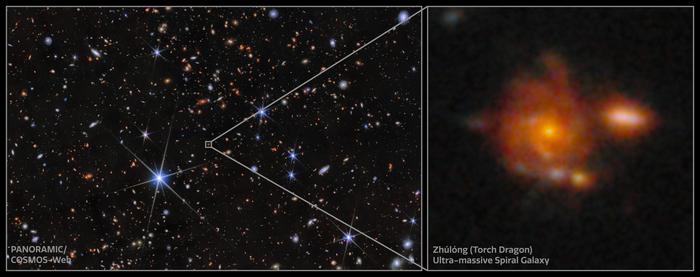In a groundbreaking achievement, astronomers have unveiled the existence of Zhúlóng, the most distant spiral galaxy ever discovered, shining through the cosmos from an era merely one billion years after the Big Bang. Located at a staggering redshift of 5.2, this celestial marvel provides evidence contradicting long-standing theories regarding the timeline of galaxy formation. While large spiral galaxies like our Milky Way are typically found in relative proximity to Earth, their counterparts from ancient epochs have remained elusive—until now.
The discovery of Zhúlóng has been attributed to the PANORAMIC Survey, a wide-area imaging project being meticulously conducted using the James Webb Space Telescope (JWST). This pioneering survey aims to explore the incredible early Universe, attempting to bridge insights into massive galaxies’ formation and evolution. Assistant astronomer Christina Williams, a key figure at NSF NOIRLab and co-leader of the project, emphasized the survey’s focus on revealing massive and luminous galaxies among the earliest epochs of the Universe, an endeavor that has now borne fruit.
Zhúlóng, which translates to ‘Torch Dragon’ in Chinese mythology, symbolizes light and the passage of cosmic time. The intricate structure of the galaxy showcases remarkably well-defined spiral arms and a central bulge filled with ancient stars—structural features that closely mirror the dynamics of the Milky Way. This observation not only amplifies our understanding of galactic evolution but also raises questions about the development of spiral structures in galaxies over cosmic time.
Traditionally, it has been believed that spiral arms within galaxies take billions of years to evolve. The presence of such a well-defined and mature structure in Zhúlóng challenges this notion. Evidence suggests that this galaxy had firmly established its disks and spiral arms just a billion years post-Big Bang, highlighting the rapidity with which these massive and complex structures can form. The implications of this discovery reignite the discussion about the processes that govern galaxy formation and the timescales involved.
The PANORAMIC Survey is noteworthy, particularly as it leverages JWST’s capabilities in a novel “pure parallel mode.” This observing strategy facilitates the acquisition of additional images while the telescope is focused elsewhere, thereby optimizing time and resources. Christina Williams expressed the exhilaration of pioneering such advanced techniques utilizing state-of-the-art instrumentation. The technological innovations of JWST play a crucial role in reshaping our understanding of early galaxies, allowing astronomers to look back into time like never before.
Researchers noted that Zhúlóng possesses a surprisingly mature configuration, unlike the irregular and clumpy formations frequently observed in distant galaxies. Its mass and size are comparable to those of the Milky Way, indicating that mature galaxies may possess the capability to form earlier in the cosmic timeline than previously theorized. The rigidity of Zhúlóng’s spiral structure deserves careful examination, as it opens new avenues for understanding how similar galaxies might develop in the universe’s infancy.
The discovery also carries substantial theoretical implications. Traditionally, it has been assumed that the formation of spiral arms requires prolonged periods of stability and environmental conditions, more often seen in local galaxies. However, the characteristics observed in Zhúlóng suggest that these spiral structures can materialize within much shorter timeframes than previously conceived. This revelation could necessitate a re-evaluation of galactic evolution theories, providing new insights into the dynamics governing star formation and the interstellar medium in the young universe.
The implications of finding such a substantial spiral galaxy in the early universe extend beyond mere structural attributes. The presence of Zhúlóng raises profound questions about the evolutionary processes shaping galaxies at different epochs. It is plausible that particular evolutionary events in the early universe, such as galactic mergers, may disrupt or enhance spiral formations, suggesting that the stability of these structures may be a time-sensitive phenomenon.
As astronomical research progresses, astronomers anticipate that further observations with JWST, in conjunction with data from the Atacama Large Millimeter/submillimeter Array (ALMA), will yield deeper insights into Zhúlóng’s properties and its formation history. Continued surveys of extragalactic wide areas are expected to reveal more galaxies akin to Zhúlóng, expanding our understanding of the early universe’s complex landscape.
The combination of advanced observational techniques and powerful telescopes like the JWST not only enhances our capacity to detect distant galaxies like Zhúlóng, but it also enriches the discourse around cosmic structure formation and evolution. The active participation of leading astronomers from esteemed institutions worldwide further underscores the collaborative nature of modern astronomical research.
In summation, the discovery of Zhúlóng is not merely another notch in the belt of astronomical progress; it signifies a pivotal moment for our comprehension of cosmic history and the intricate dynamics governing galaxy formation. As we continue to peel back the layers of our universe’s infancy, galaxies like Zhúlóng will remain at the forefront of our quest for knowledge, illuminating the path towards unlocking the mysteries of our cosmic origins.
Subject of Research: Discovery of Zhúlóng, the most distant spiral galaxy
Article Title: Discovery of Zhúlóng: The Most Distant Spiral Galaxy Discovered to Date
News Publication Date: [Insert Date]
Web References: [Insert URLs]
References: [Insert References]
Image Credits: NOIRLab/NSF/AURA/NASA/CSA/ESA/M. Xiao (University of Geneva)/G. Brammer (Niels Bohr Institute)/D. de Martin & M. Zamani (NSF NOIRLab)
Keywords
Spiral Galaxy, Zhúlóng, JWST, Early Universe, Astrophysics, Galaxy Formation, Cosmology, Redshift, Spiral Arms




